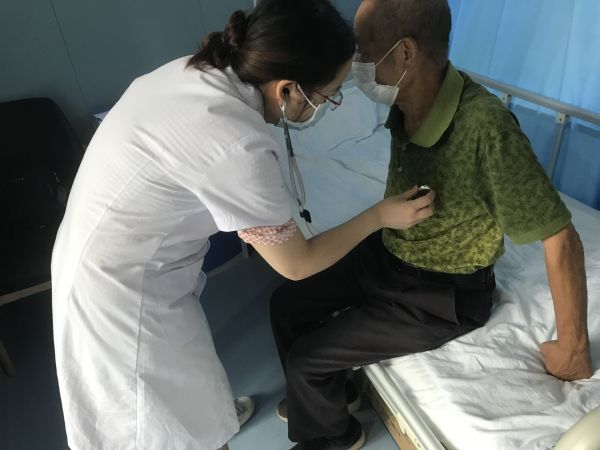"China Respiratory Slow Disease Management 21st Century New Journey" Special Report ⑫ | Huang Kewu: Further improve the penetration rate of grass -roots drugs and help long -term control of asthma
Author:Medical newspaper Time:2022.09.17

Physician News (Wang Lu Wang Lu) Chronic respiratory diseases and cardiovascular and cerebrovascular diseases, diabetes and cancer are listed by the World Health Organization as the world's four major chronic diseases. However, Professor Huang Kewu, the Department of Respiratory and Measure Medicine of Beijing Chaoyang Hospital affiliated to the Capital Medical University, introduced that compared with other three types of chronic diseases such as cardiovascular and cerebrovascular diseases, the public's awareness and emphasis on chronic respiratory diseases is far lower. To some extent, respiratory diseases represented by chronic obstruction and asthma are the shortcomings of the shortcomings of the chronic disease management system in my country.

Professor Huang Kewu
The initial results of the prevention and control of breathing slow diseases have been effective, and the diagnosis and treatment system is yet to be improved
At present, there are about 100 million patients with chronic pulmonary patients in my country, 45.7 million patients with asthma patients over 20 years old and above. In contrast to high incidence and high mortality, less than 3%of patients in my country know that they are sick 1, and only 14.2%of patients with asthma have reached good control 3. "Asthma is different from slow lung blocking. The patients include children, youths, and elderly all ages." Professor Huang Kewu introduced, "In addition, some patients manifest themselves as typical symptoms such as cough and chest tightness. The number of patients with asthma may exceed 60 million. "
In 2017, the "Medium- and Long-term Plan for Chronic Diseases (2017-2025)" issued by the General Office of the State Council proposed that it is necessary to do a good job of deployment of chronic disease prevention and treatment in the next 5 to 10 years, reducing the burden on the disease, improving the health expectations of residents, and striving for all aspects To ensure people's health throughout the cycle. Prior to this, medical staff of the people and even some grass -roots medical institutions in our country attached great importance to slow respiratory diseases. Early identification and diagnosis ability and awareness were not strong. Basic inspection equipment and drugs related to grass -roots were relatively lacking.
Thanks to the country's vigorous promotion, the control of chronic respiratory diseases has gradually attracted attention. In recent years, whether it is national project funding, or the configuration of the grass -roots lung function equipment, or the knowledge training of medical staff of chronic respiratory diseases at the grassroots level, it has improved significantly. In the past, the lack of drugs in the grass -roots community health service centers also improved by the promotion of experts in national policies and breathing. However, the increase in the number of chronic pulmonary patients caused by the aging of the population and the increase in allergic asthma patients caused by the lifestyle and environmental changes are reminding us that the challenges facing chronic respiratory diseases in our country are still severe.
Professor Huang Kewu emphasized that what needs to be done in the next step is to further do it and in place that the problems that can be resolved. As a window for many patients in my country, grass -roots medical institutions should be more familiar with the clinical manifestations of the disease, be vigilant, and be alert to risk factors of the disease, and achieve the purpose of early treatment of diseases. At the same time, we must establish a two -way referral mode between the grassroots and higher -level hospitals, further improve the management system, and help prevent and control slow respiratory diseases.
Standardize the whole process, the main theme of breathing slow disease management
Although the level of respiratory disease diagnosis and treatment has made great progress since the 21st century, respiratory diseases represented by asthma and chronic obstructive pulmonary diseases are still unable to achieve clinical cure. Treatment goals to control the disease, avoid acute aggravation, seizures and reduction of reduction The risk of death is mainly, which also explains why the management of slow respiratory diseases cannot be just overnight. The standardized management trend of long -term systems is imperative, and it is imminent to promote standardized medication.
Long -term respiratory slow disease management requires the work of both doctors and patients to work together and actively cooperate. First of all, we must strengthen public health literacy and increase the public's concept of prevention of slow respiratory diseases and the patient's attention to slow respiratory diseases. Taking asthma as an example, the proportion of patients who can truly achieve the target of asthma treatment clinically is not high. The reason is not that asthma is difficult to treat, but that the patient's awareness of the disease is not enough. Medication brings difficulties for disease management. Therefore, in the treatment of asthma, patients must first recognize the significance of long -term standards for control over disease control.
Secondly, strengthen the standard education of patients and their families, and emphasize the importance of self -management and regular follow -up of patients. Patients with chronic respiratory diseases receive long -term regulatory treatment does not mean that patients are required to use the same dose of drugs for a long time. In the process, the medication needs to be adjusted according to the situation. Huang Kewu believes that this requires medical staff to strengthen the education of patients' medication guidance and precautions after discharge.
Finally, promote the implementation of graded diagnosis and treatment to achieve closed -loop management of slow respiratory diseases. The first, secondary, and third -level hospitals jointly constitute a hierarchical diagnosis and treatment full chain, which is conducive to optimizing the allocation of medical and health resources, rationally guided patients to divert, and jointly realizing closed -loop management of patients with slow respiratory diseases. "For example, patients with poor respiratory failure and poor lung function may need to go to large hospitals for treatment as soon as possible, and after treatment, they can return to the community for targeted management, including early diagnosis and intervention, or can be completed in grassroots medical institutions." Only by organically connecting the functions of different medical institutions can we achieve slow breathing disease around patients.
Drug popularization must keep up with the development of the diagnosis and treatment plan
At present, the treatment of clinical clinical pneumocked pulmonary is based on bronchial dilatants; asthma is mainly important treatment methods based on inhalation glycogenia hormone (ICS). However, it is also gradually discovered that some patients may have the characteristics of two diseases: slow pulmonary and asthma: some chronic obstructive pulmonary may also have some asthma characteristics; there are also patients with asthma patients with severe lung function. Diagnosis criteria. Such patients are often clinically referred to as asthma-chronic lung overlapping (ACO). Compared with patients with asthma or slow pulmonary, ACO patients have worse lung function, more frequent acute aggravation, complications, hospitalization risks, mortality and medical utilization rates higher, and worse quality of life. The inhalation therapy is the cornerstone of patients with ACO. The "Guidelines for Chronic Obstructive Pulmonary Diseases (Revised Edition 2021)" is recommended to combine asthma or asthma characteristics to strongly start ICS treatment scheme 4. my country's 2020 version of the bronchial asthma prevention and control guide also recommends that ICS/LABA/LAMA is used for the treatment of ACO patients. The three -united inhaled preparations are particularly important to reduce the risk of acute and death in the medium weight. Rehabilitation, vaccination and complications of complications 5.
In recent years, there have been many progress on chronic respiratory diseases. The content covers the pathogenesis mechanism, early diagnosis, and drug applications. Among them, targeted therapy is also a hot spot. At present, there are many cytokine-targeted drugs for cellular inflammation of asthma.
Professor Huang Kewu introduced that inhalation of glucocorticoids, bronchiectasis, and certain phlegm drugs have been incorporated into the scope of medical insurance, and it can ensure the accessibility of patients at the grassroots level.
But the degree of popularity like Sanlian drugs and biological preparations is not so high. "Such drugs may only gradually enter medical insurance at some large hospitals, but they have not yet entered the grassroots level." Professor Huang Kewu said, "I believe that with the expansion of my country's medical insurance coverage and the increase in levels, there will be more clinical clinical in the future that can make the clinic clinical Drugs benefited by patients are incorporated into medical insurance, and more drugs with more innovative mechanisms will also benefit more patients through the further improvement of the hierarchical diagnosis and treatment system. "
references:
[1]Wang C, Xu J, Yang L, et al. Prevalence and risk factors of chronic obstructive pulmonary disease in China (the China Pulmonary Health [CPH] study): a national cross-sectional study. Lancet. 2018 Apr 28; 391 (10131): 1706-1717.
[2] Huang K, yang T, xu j, et al. Prevalence, RISK FACTORS, and Management of Asthma in China: A National Cross-Sectional Study [J]. The Lancet, 2019, 394 (10196).
[3] Ding B, Small M, WANG W, Et Al. Disease Burden of Mild Asthmatics in China [J]. EUROPEAN Respiratory Journal, 2016, 48 (SUPPL 60): PA4208.
[4] Chronic obstructive pulmonary disease group of the Chinese Medical Association Respiratory Diseases Branch, the Chinese Medical Association Breathing Physician Branch Chronic Obstructive Lung Disease Work Committee. Tuberculosis and breathing magazine, 2021, 44 (3): 36.
[5] Zhou Xin, Shen Huahao, et al.. Circini asthma prevention guide (2020 edition) [J]. Chinese tuberculosis and breathing magazine, 2020, 43 (12): 26.
8 special lines in the north, Guangzhou -Hangzhou 4 places have been launched! The train will be equipped with 22 academicians including Academician Zhong Nanshan/Master of Chinese Medicine/National Medical Medicine, 145 Hospital Management Experts, and 1,582 medical elites of 1,220 public welfare tour posters. Passengers "intimate contact"! At the same time, the general poster video will cover 13,000 TVs on the subway and platforms on the 1st, 5th, 5th, 8th, 13th and Batong lines in Beijing, and the platform will be played many times a day. It is expected that the number of viewing will exceed 100 million!

Wonderful video retrospective of public welfare tour exhibition:
Tribute to Chinese Physician's Day
Tribute to Chinese Physician's Day · Health China, you and I.
Tribute to Chinese Physician's Day · Health China, you and me, 68 | Li Shengping: Standing at the commanding height of pancreatic biliary surgery to help hospitals build a world -class tumor center
Tribute to Chinese Physician's Day
Tribute to Chinese Physician's Day
Tribute to Chinese Physician's Day · Health China, you and I. Move 65 | Professor Xue Wei: Don't just be a surgery, treat patients as "people"!
Capture: Wang Lu
Edit: Wang Lu
- END -
Eat 6 composite vitamins a day, the man's own abuse caused by abnormal liver function

Wuhan Evening News, July 21, thought that he was lacking in vitamins a day a day, ...
Hainan Oriental High Risk Zone was adjusted to 56, and the mid -risk zone was adjusted to 5

On August 20th, the reporter learned from the new type of coronary virus pneumonia...